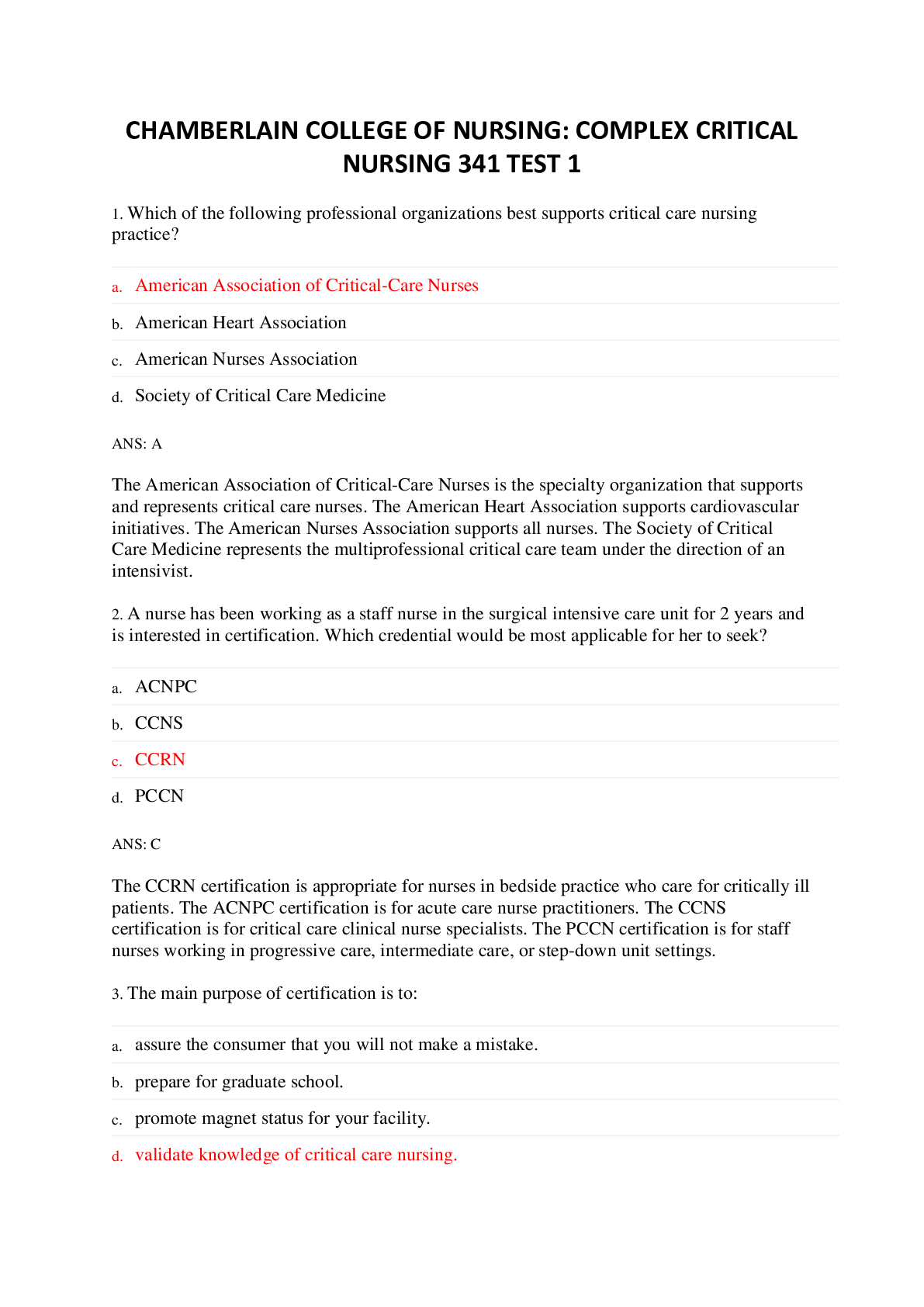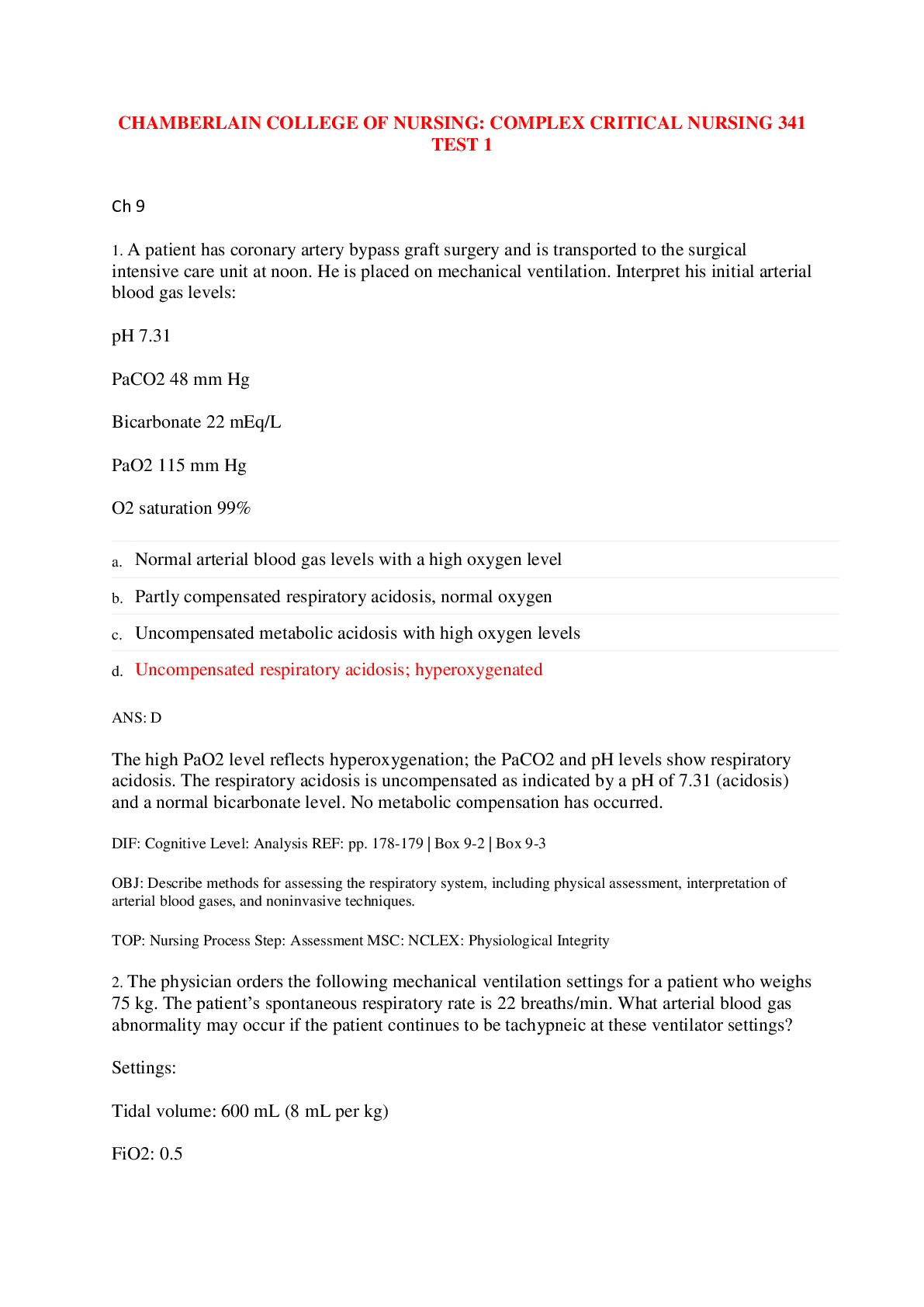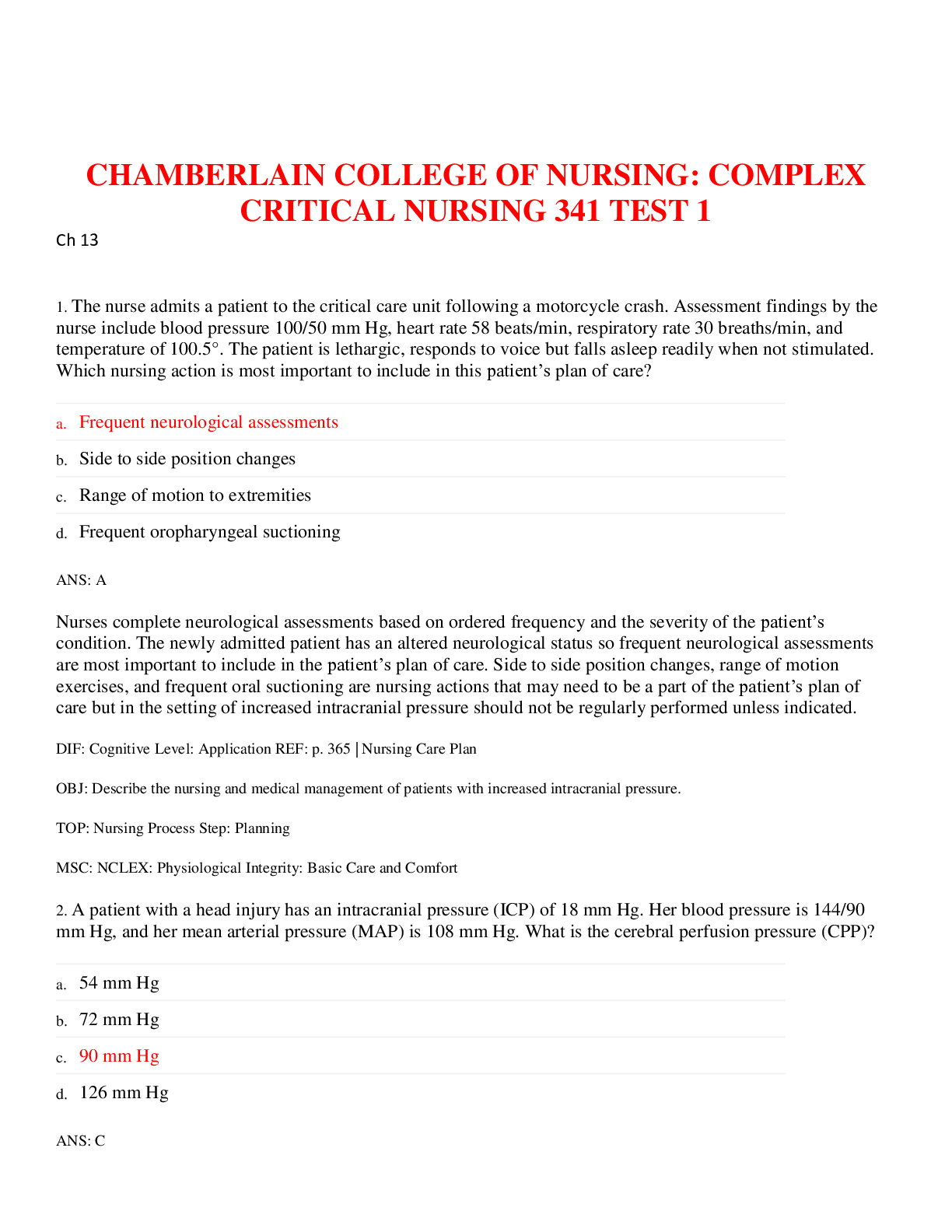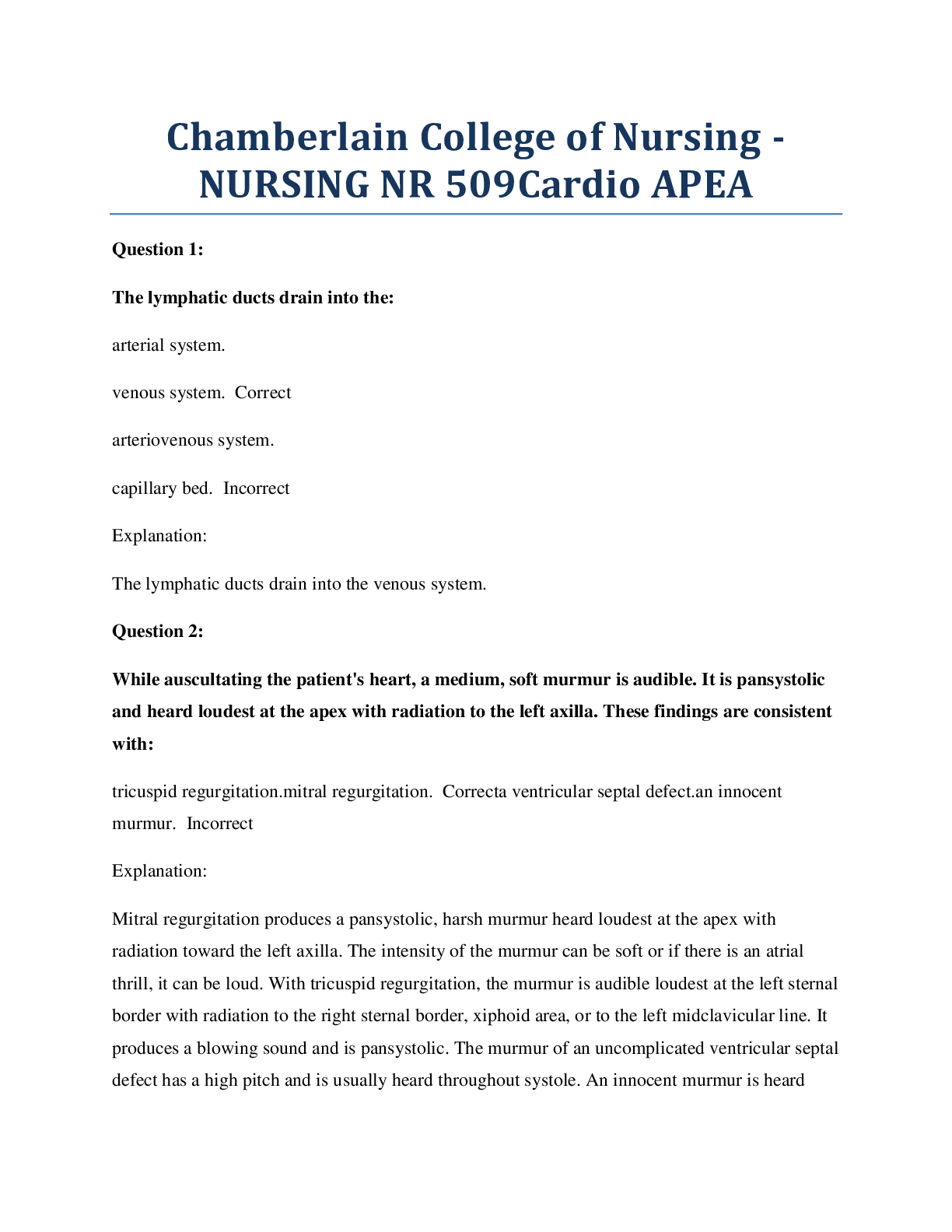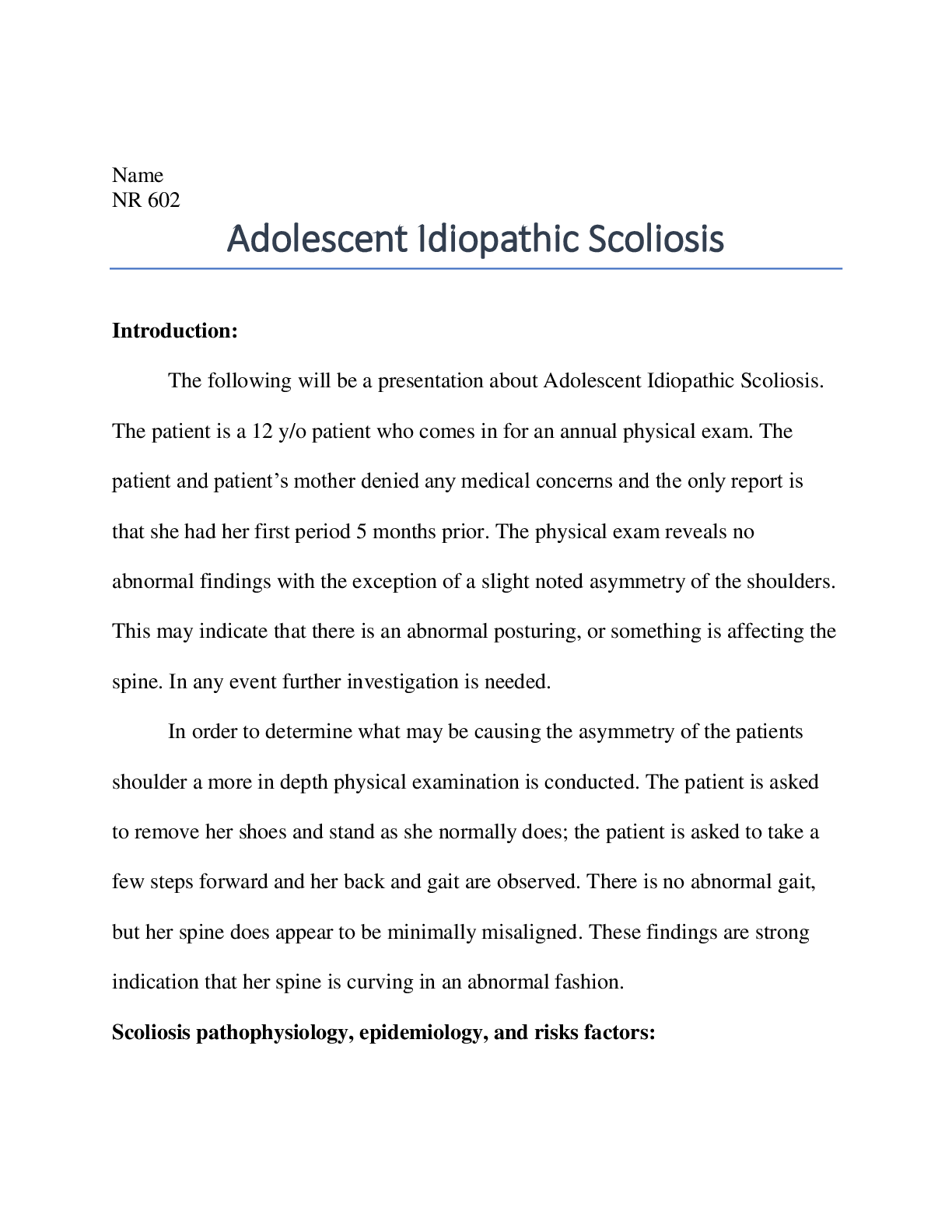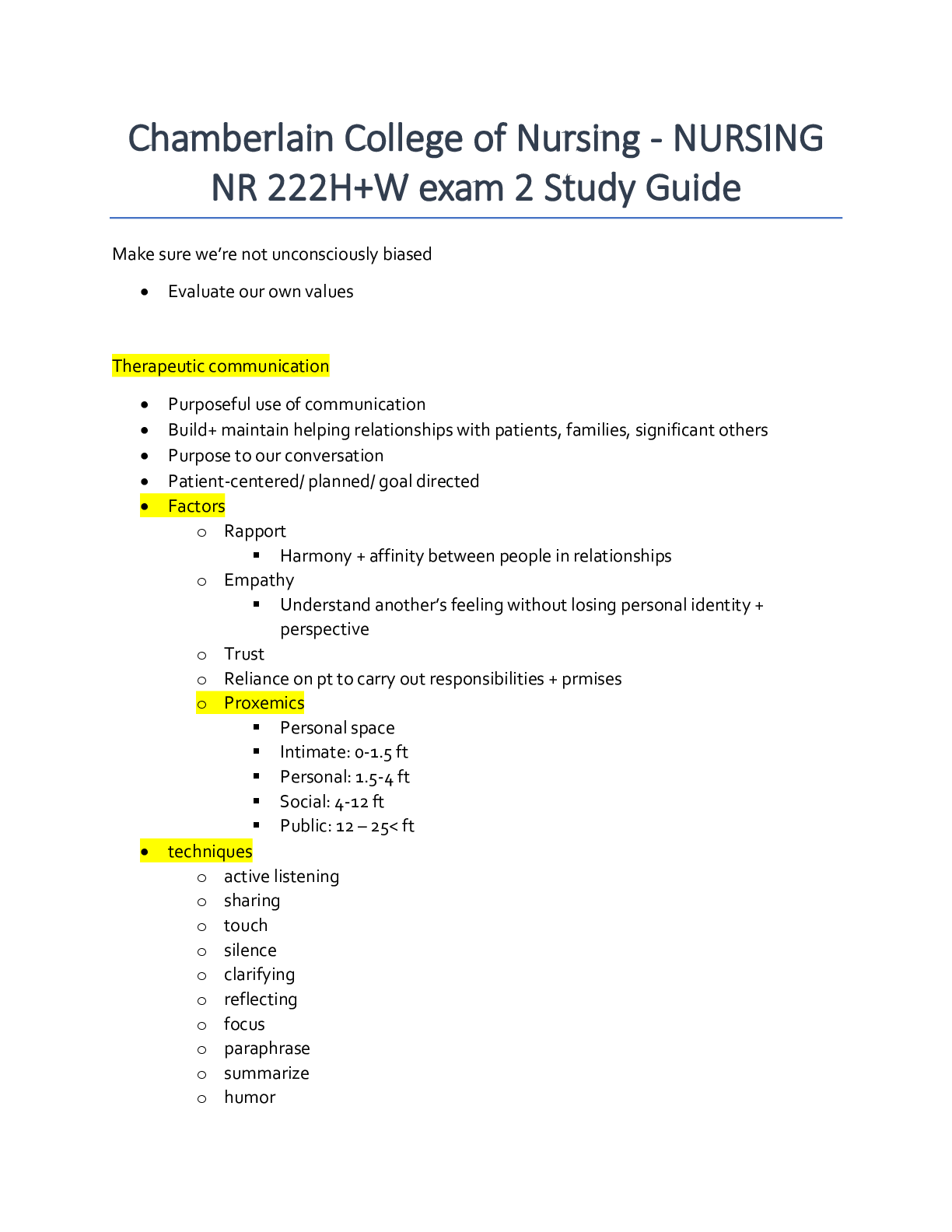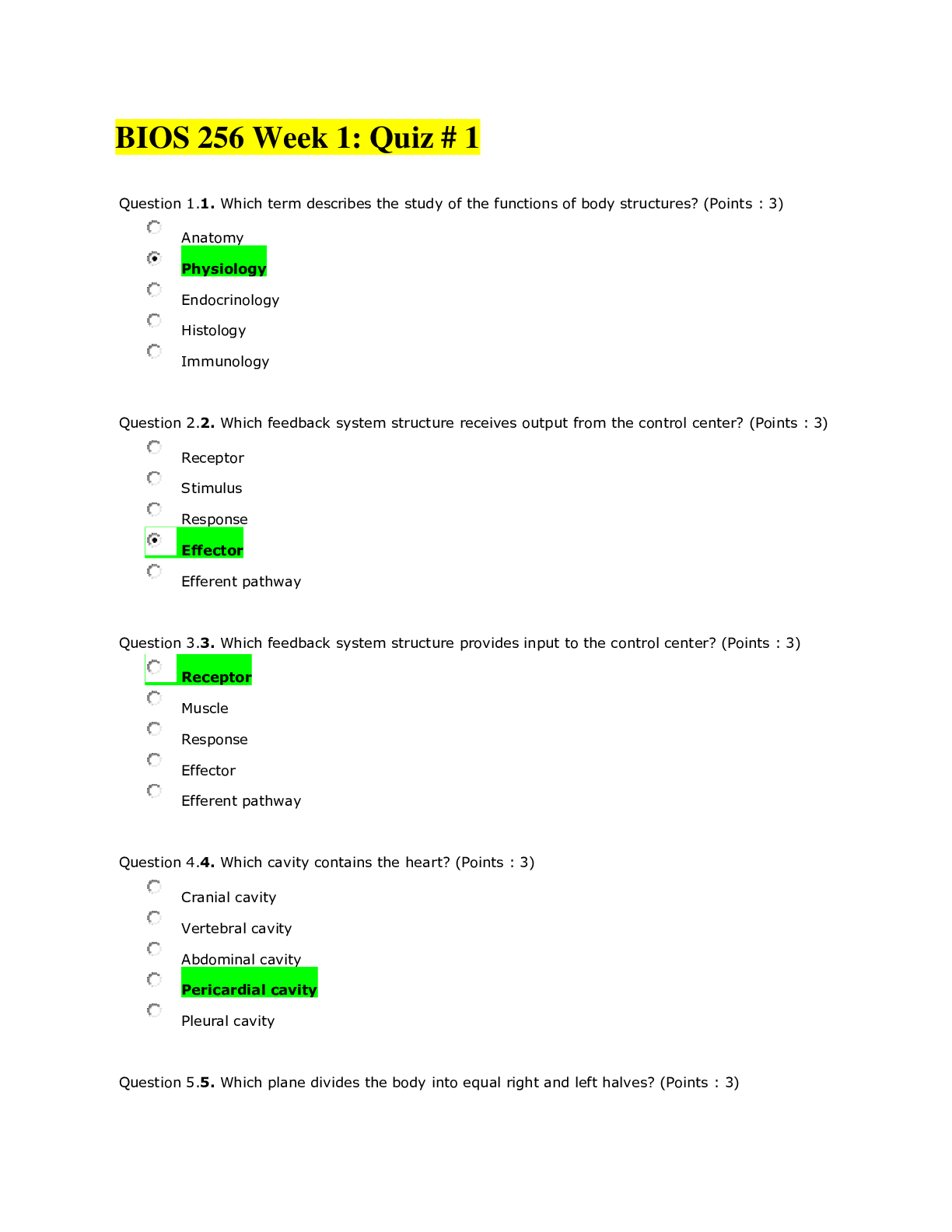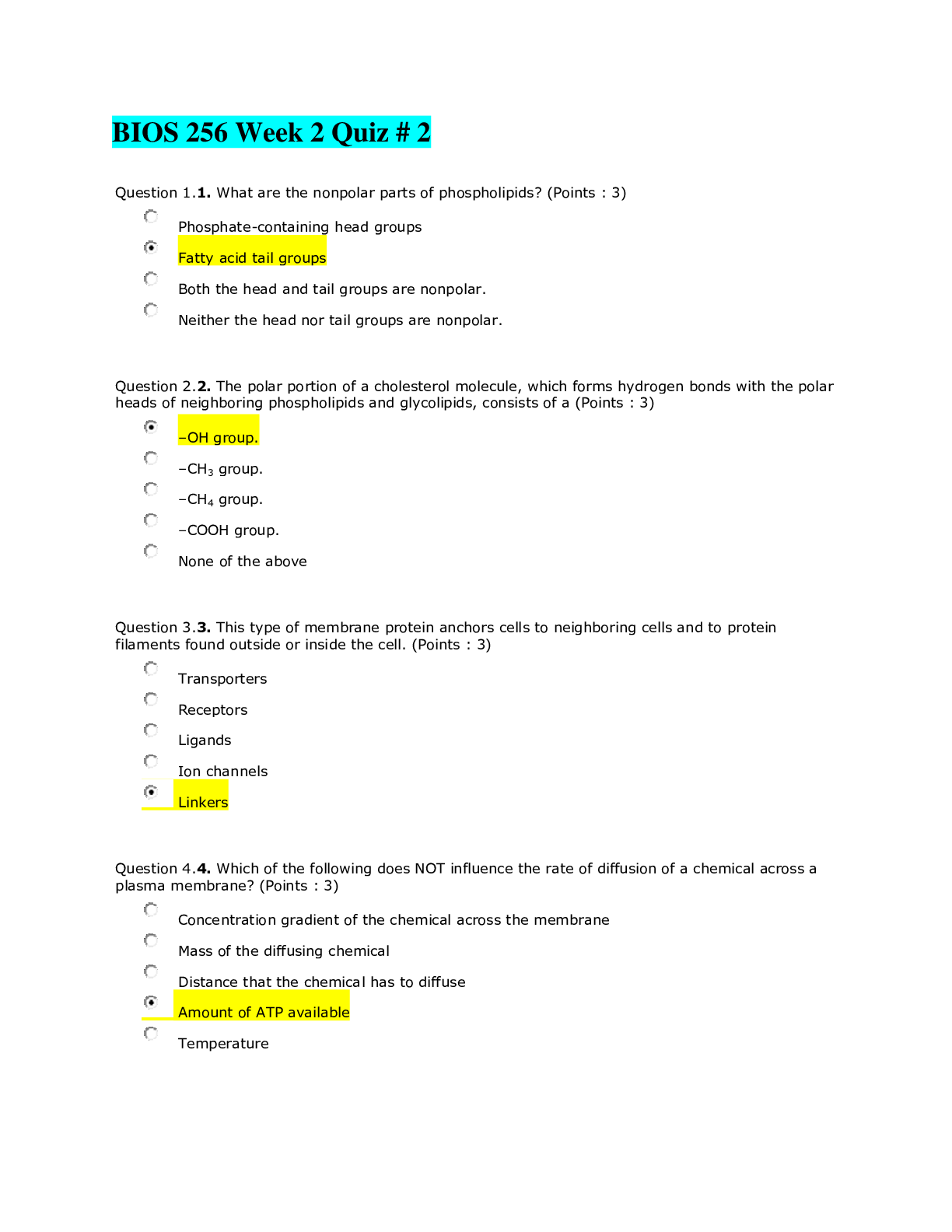Health Care > QUESTIONS & ANSWERS > ATI Care of the Patient with Acute Coronary Syndrome, Chapter 7: Perrin: Understanding the Essential (All)
ATI Care of the Patient with Acute Coronary Syndrome, Chapter 7: Perrin: Understanding the Essentials of Critical Care Nursing: Chamberlain College of Nursing NR 341 (A Graded) Latest Questions and Complete Solutions
Document Content and Description Below
ATI Care of the Patient with Acute Coronary Syndrome, Chapter 7: Perrin: Understanding the Essentials of Critical Care Nursing: Chamberlain College of Nursing NR 341 (A Graded) Latest Questions and Co... mplete Solutions Perrin: Understanding the Essentials of Critical Care Nursing Chapter 7: Care of the Patient with Acute Coronary Syndrome MULTIPLE CHOICE. Choose the one alternative that best completes the statement or answers the questions 1) A patient says to his nurse, "I've never heard of an acute coronary syndrome. Please explain what happened to me." The nurse should respond, "Acute coronary syndrome is: A) Another name for a myocardial infarction (MI) or heart attack." B) A group of disorders that result in insufficient oxygen supply to the heart." C) The second leading cause of death in the United States." D) A type of abnormal heart rhythm." Answer: B Explanation: A) This is the definition and/or criteria that guide a diagnosis of ACS. #1 is incorrect. An MI/heart attack is only one of the disorders that falls under this group of disorders. An MI includes tissue necrosis from arterial obstruction. #3 is incorrect. ACS is the number leading cause of death in United States. #4 is incorrect. A cardiac arrest does not always occur when ACS is present. Cardiac arrest is a possibility but it does not occur in every patient. Nursing Process: Evaluation Cognitive Level: Comprehension Category of Need: Psychosocial Integrity B) This is the definition and/or criteria that guide a diagnosis of ACS. #1 is incorrect. An MI/heart attack is only one of the disorders that falls under this group of disorders. An MI includes tissue necrosis from arterial obstruction. #3 is incorrect. ACS is the number leading cause of death in United States. #4 is incorrect. A cardiac arrest does not always occur when ACS is present. Cardiac arrest is a possibility but it does not occur in every patient. Nursing Process: Evaluation Cognitive Level: Comprehension Category of Need: Psychosocial Integrity C) This is the definition and/or criteria that guide a diagnosis of ACS. #1 is incorrect. An MI/heart attack is only one of the disorders that falls under this group of disorders. An MI includes tissue necrosis from arterial obstruction. #3 is incorrect. ACS is the number leading cause of death in United States. #4 is incorrect. A cardiac arrest does not always occur when ACS is present. Cardiac arrest is a possibility but it does not occur in every patient. Nursing Process: Evaluation Cognitive Level: Comprehension Category of Need: Psychosocial Integrity D) This is the definition and/or criteria that guide a diagnosis of ACS. #1 is incorrect. An MI/heart attack is only one of the disorders that falls under this group of disorders. An MI includes tissue necrosis from arterial obstruction. #3 is incorrect. ACS is the number leading cause of death in United States. #4 is incorrect. A cardiac arrest does not always occur when ACS is present. Cardiac arrest is a possibility but it does not occur in every patient. Nursing Process: Evaluation Cognitive Level: Comprehension Category of Need: Psychosocial Integrity 2) Which of the following is an accurate description of the progression of events in an acute coronary syndrome (ACS)? A) A thin fibrin layer stabilizes the ruptured plaque and prevents the occlusion of coronary vessels when stable angina is present in ACS. B) When complete platelet occlusion occurs in a vessel, the ECG changes include nonspecific ST elevation without necrosis occurring in ACS. C) The growth of platele- rtich thrombi in the smaller vessels creates a blockage and is the cause for unstable angina symptoms in ACS. D) Sudden plaque buildup in a narrow vessel immediately leads to an acute myocardial infarction when stable angina is present in ACS. Answer: C Explanation: A) Unstable angina occurs when a blockage from pla-terilceht thrombi in smaller vessels occurs, causing myocardial ischemia. Because ischemic pattern of pain varies, it is unpredictable and can occur with exertion and rest. Eventually, the patient will limit activity to minimize the symptoms. #1 is incorrect. The formation of fibrin along the area of ruptured plaque will stabilize the thrombi and fully occlude the coronary vessel. Therefore, with full occlusion an STEMI occurs. #2 is incorrect. When occlusion occurs, ST elevation occurs; necrosis and ischemia are a result of the decreased blood flow. Ischemic and necrotic tissue has decreased contractility, causing decreased cardiac output. #4 is incorrect. The buildup of plaque takes a longer period and will not give immediate symptoms of an MI. Stable angina occurs in a predictable manner, because there is gradual reduction of the vessel lumen size and other vessels may compensate for this minor hypoxia until the vessel is completely occluded. Nursing Process: Evaluation Cognitive Level: Analysis Category of Need: Psychosocial Integrity B) Unstable angina occurs when a blockage from pla-terilceht thrombi in smaller vessels occurs, causing myocardial ischemia. Because ischemic pattern of pain varies, it is unpredictable and can occur with exertion and rest. Eventually, the patient will limit activity to minimize the symptoms. #1 is incorrect. The formation of fibrin along the area of ruptured plaque will stabilize the thrombi and fully occlude the coronary vessel. Therefore, with full occlusion an STEMI occurs. #2 is incorrect. When occlusion occurs, ST elevation occurs; necrosis and ischemia are a result of the decreased blood flow. Ischemic and necrotic tissue has decreased contractility, causing decreased cardiac output. #4 is incorrect. The buildup of plaque takes a longer period and will not give immediate symptoms of an MI. Stable angina occurs in a predictable manner, because there is gradual reduction of the vessel lumen size and other vessels may compensate for this minor hypoxia until the vessel is completely occluded. Nursing Process: Evaluation Cognitive Level: Analysis Category of Need: Psychosocial Integrity C) Unstable angina occurs when a blockage from pla-terilceht thrombi in smaller vessels occurs, causing myocardial ischemia. Because ischemic pattern of pain varies, it is unpredictable and can occur with exertion and rest. Eventually, the patient will limit activity to minimize the symptoms. #1 is incorrect. The formation of fibrin along the area of ruptured plaque will stabilize the thrombi and fully occlude the coronary vessel. Therefore, with full occlusion an STEMI occurs. #2 is incorrect. When occlusion occurs, ST elevation occurs; necrosis and ischemia are a result of the decreased blood flow. Ischemic and necrotic tissue has decreased contractility, causing decreased cardiac output. #4 is incorrect. The buildup of plaque takes a longer period and will not give immediate symptoms of an MI. Stable angina occurs in a predictable manner, because there is gradual reduction of the vessel lumen size and other vessels may compensate for this minor hypoxia until the vessel is completely occluded. Nursing Process: Evaluation Cognitive Level: Analysis Category of Need: Psychosocial Integrity D) Unstable angina occurs when a blockage from pla-terilceht thrombi in smaller vessels occurs, causing myocardial ischemia. Because ischemic pattern of pain varies, it is unpredictable and can occur with exertion and rest. Eventually, the patient will limit activity to minimize the symptoms. #1 is incorrect. The formation of fibrin along the area of ruptured plaque will stabilize the thrombi and fully occlude the coronary vessel. Therefore, with full occlusion an STEMI occurs. #2 is incorrect. When occlusion occurs, ST elevation occurs; necrosis and ischemia are a result of the decreased blood flow. Ischemic and necrotic tissue has decreased contractility, causing decreased cardiac output. #4 is incorrect. The buildup of plaque takes a longer period and will not give immediate symptoms of an MI. Stable angina occurs in a predictable manner, because there is gradual reduction of the vessel lumen size and other vessels may compensate for this minor hypoxia until the vessel is completely occluded. Nursing Process: Evaluation Cognitive Level: Analysis Category of Need: Psychosocial Integrity [Show More]
Last updated: 1 year ago
Preview 1 out of 34 pages
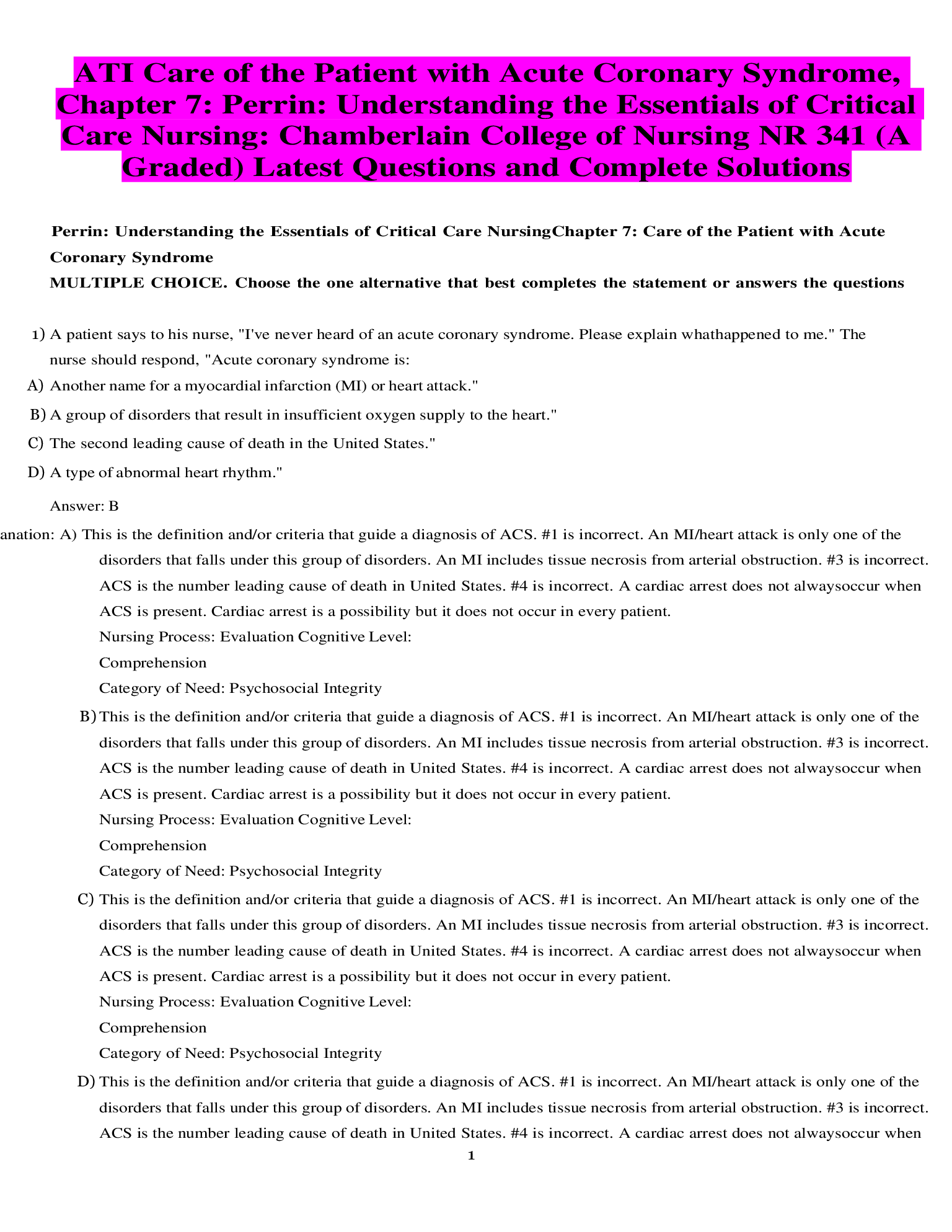
Buy this document to get the full access instantly
Instant Download Access after purchase
Add to cartInstant download
We Accept:

Reviews( 0 )
$15.50
Document information
Connected school, study & course
About the document
Uploaded On
May 24, 2021
Number of pages
34
Written in
Additional information
This document has been written for:
Uploaded
May 24, 2021
Downloads
0
Views
39


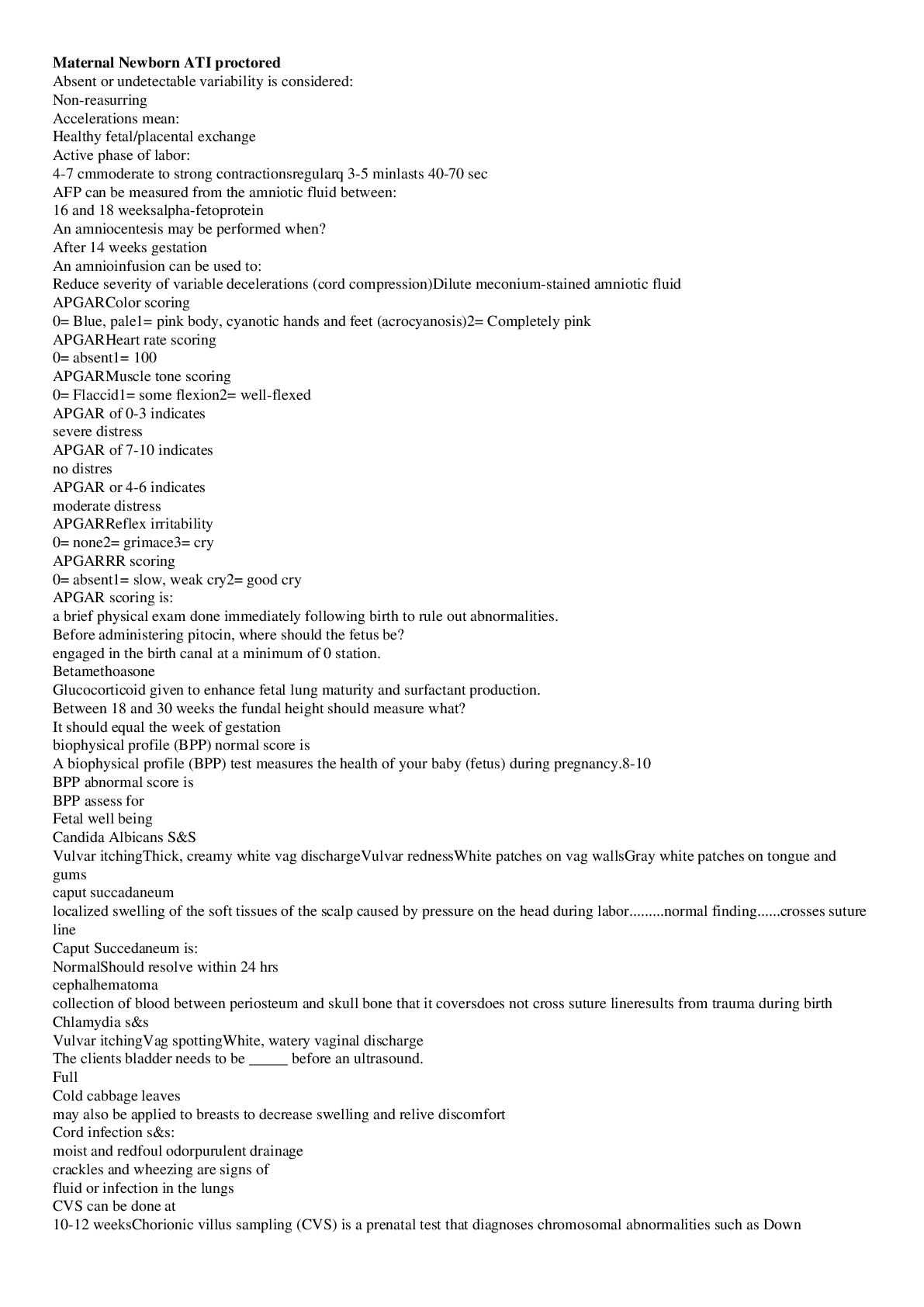
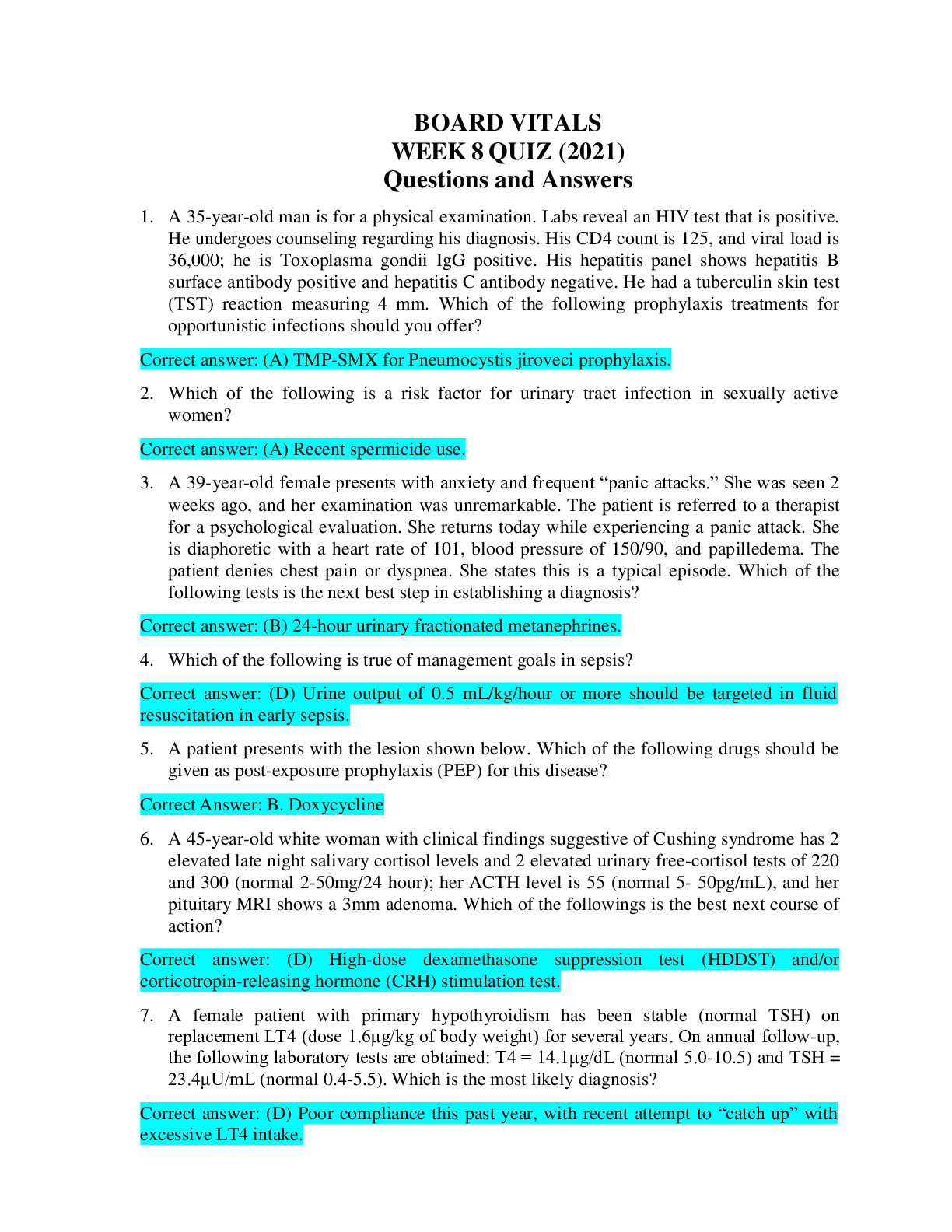

, (A Grade), Questions and Answers, All Correct Study Guide, Download to Score A.png)
, Questions and Answers, All Correct Study Guide, Download to Score A.png)
, Latest Questions and Answers with Explanations, All Correct Study Guide, Download to Score A.png)
, Latest Questions and Answers with Explanations, All Correct Study Guide, Download to Score A.png)
, Latest Questions and Answers with Explanations, All Correct Study Guide, Download to Score A.png)
, Latest Questions and Answers with Explanations, All Correct Study Guide, Download to Score A.png)
 (Verified Answers, COMPLETE GUIDE FOR EXAM PREPARATION).png)
 All Correct Answers, Download to Score A.png)
